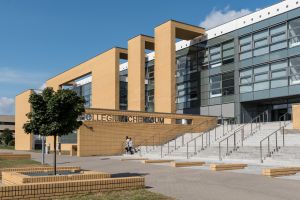Dear Sirs and Madams
We welcome you to the following lecture in the series of the Stanisław Ulam Lecture in the School of Natural Sciences, scheduled to be held on 12th November at 4.15 p.m. in the Auditorium of the Collegium Chemicum.
The lecture, entitled ‘Directed Block Copolymer Self-Assembly as a Building-Block Route to Novel Hierarchical Superstructures’, will be given by Professor Richard Spontak of North Carolina State University in Raleigh, United States. Following the lecture, you are invited to join us for coffee and conversation with Professor Spontak.
Abstract
Spontaneous self-assembly of block copolymer (BCP) molecules in a block-selective solvent typically results in the formation of micelles possessing a classical spherical morphology. Inclusion of a crystallizable block in the copolymer promotes crystallization-driven self-assembly (CDSA), yielding anisotropic cylindrical micelles that can, after additional processing, possess a remarkably narrow length dispersity. Anisotropic nanoparticles prepared from BCPs are of growing importance as building blocks for the creation of a wide range of synthetic hierarchical materials. However, the assembly of such structural units is generally limited to the use of amphiphilic interactions. In addition to CDSA to generate single cylindrical micelles, reversible coordination-driven hierarchical self-assembly can be used to produce micron-scale fibers and macroscopic films based on the association of low- polydispersity cylindrical BCP micelles. In this case, coordination of palladium metal centers to phosphine ligands immobilized within the soluble coronas of BCP micelles is observed to induce intermicellar crosslinking, affording stable linear fibers comprised of micelle subunits in a staggered arrangement. The mean length of the fibers can be readily varied by altering the micelle concentration, reaction stoichiometry or aspect ratio of the micelle building blocks. Furthermore, the fibers aggregate upon drying to form robust, self-supporting macroscopic micelle-based thin films with useful mechanical properties that are analogous to crosslinked polymer networks, but on a significantly longer length scale. A comparable hierarchical self- assembly strategy yields toroidal micelles that combine to form micron-scale superstructures. Addition of a crystallizable BCP to a solution of a toroid-forming BCP results in the formation of toroidal multimicelles, as well as single-layer hexagonal arrays of connected toroids. By controlling the ability of the BCPs to form hydrogen bonds through the introduction of hydroxyl groups on the crystallizable BCP and the accompanying level of solvophobic interactions, the BCPs can spontaneously self-assemble to form 3D periodic nanoporous superstructures. These studies demonstrate that self-assembly of BCPs into discrete, non-spherical nanostructures can be scaled up to yield materials with intriguing morphologies and properties. We lastly consider commercial thermoplastic elastomers with crystallizable endblocks.
Biography
Richard J. Spontak, a Distinguished Professor at NC State University, received his Ph.D. from UC Berkeley and pursued post-doctoral research at Cambridge University before joining P&G in 1990 and NC State in 1992. He has published over 300 peer-reviewed journal papers and 40 book chapters and invited works, and delivered over 400 invited presentations worldwide. He has received numerous research awards including the NC State Holladay Medal for Excellence, the ACS-PMSE Tess Award, the SPSJ International Award, the IChemE Underwood Medal and Global Award, the ACS-RUBB Chemistry of Thermoplastic Elastomers Award, the SPE International Award, and the IOM3 Colwyn Medal and Medal for Excellence. A fellow of IOM3, ACS-PMSE, APS and RSC, he is a member of the Norwegian Academy of Technological Sciences and holds an honorary doctorate from NTNU.
photo by Łukasz Woźny
